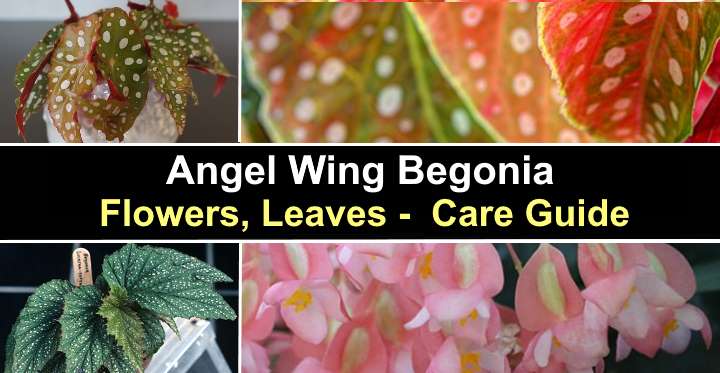Angel wing begonia, also known for its gorgeous speckled wing-like pointed leaves, is a kind of tender perennial cane begonia. An angel wing begonia not only has stunning leaves, but it also produces clusters of drooping pink, white, red, or orange blossoms. Angel wing begonia is a popular outdoor garden plant and tropical houseplant that is quite easy to maintain. For this carefree plant, partial-shade is ideal outdoors. The begonia, on the other hand, thrives in indirect light and does not like direct sunlight.
Borders, container gardens, and shady landscapes are ideal habitats for angel wing begonias with upright cane-like stems, wing-shaped leaves, and mounding evergreen foliage. Angel wing begonias are also excellent choices for hanging baskets and container planting. With the flowers dangling over the side, the begonia’s decorative long triangular leaves with speckled and dotted designs appear stunning.
This is a comprehensive guide to caring for an angel wing begonia. You’ll understand how to cultivate this delicate perennial foliage plant in a tropical environment after reading this article. You’ll get advice on growing angel wing begonia houseplants if you live in temperate areas.
How to Care for Angel Wing Begonia
Plant angel wing begonia in loamy, rich, well-drained soil that is constantly moist to encourage its development. In the winter, mulch may help keep the earth moist. Partial-shade is the best environment for the angel wing begonia. Temperatures should be kept above 55°F (13°C) at all times outdoors.
Bring angel wing begonias indoors for the winter in temperate areas to overwinter them and protect them from chilly and freezing weather. Like any tropical houseplant, care for indoor angel begonias as you would.
Facts About Angel Wing Begonia (Begonia coccinea x Begonia aconitifolia)
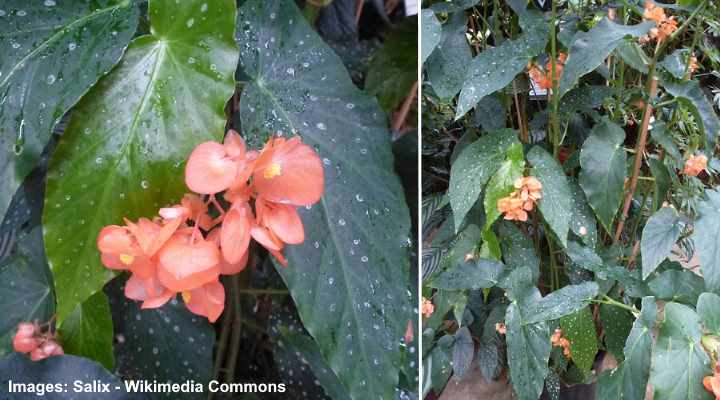
Begonia coccinea x Begonia aconitifolia belongs to the family Begoniaceae and is a kind of cane begonia that cannot tolerate cold temperatures. The cane begonia plant has stout, upright stems, which gives it its name. The angel wing hybrid is a fast-growing plant with decorative triangular, or pointed leaves, like all types of cane begonias.
Begonia coccinea and Begonia aconitifolia are two begonia species that have been combined to create ornamental angel wing begonias.
Begonia coccinea—Cane-like stems, oblong or ovate broad leaves with silvery dots or speckles, and scarlet begonia or coralBegonia are all terms for the same plant. Pendulous coral-red or pink flower clusters dangle from red stalks that bloom throughout the summer in the Begonia coccinea.
Begonia aconitifolia—Lobed leaves with serrated margins and sunken veins are also known as metallica begonia or holly-leaf begonia. The green leaves on red stems are embellished with silvery speckles, similar to the angel wing begonia. The gorgeous drooping pinkish-white flower clusters of the Begonia aconitifolia add to its appeal.
Despite the fact that angel leaf begonia is an evergreen perennial, it is treated as an annual in cold winter areas since it cannot tolerate frigid temperatures. As a result, the angel wing begonia must be brought inside from late fall until spring, when the danger of frost has passed. Like species of wax begonias, this is done by bringing it inside. Angel wing begonias, on the other hand, are just as simple to cultivate as wax begonias.
Angel wing begonias come in a variety of sizes, from one foot to two feet. It is about 5 feet (0.3 to 1.5 meters) tall. Angel wing begonias thrive in garden settings where they grow taller in the ground. Angel wing begonia houseplants grow to be 12″ to 20″ (30 – 50 cm) tall and broad, with a spread of up to 24″. Pruning, on the other hand, helps to limit the plant’s expansion.
Angel Wing Begonia Flowers
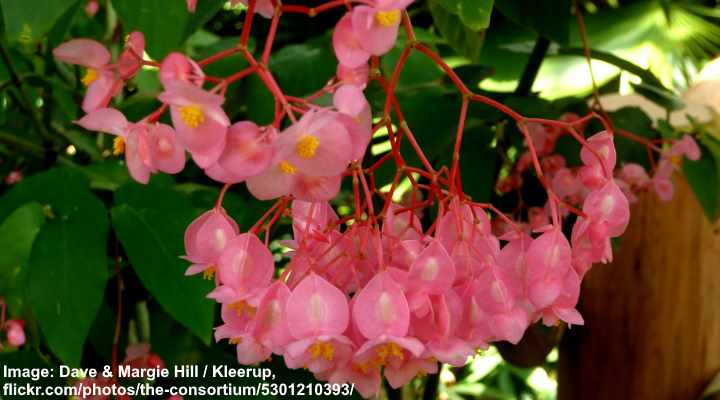
Little, colorful waxy-type blooms appear in huge dangling clusters on Angel wing begonia ‘Pink Shasta. Pink, red, or orange blooms make up the majority of the drooping blossoms. The pinkish flowers are set off nicely by the tiny yellow stamens. The robust red stems of angel wing begonia blooms are another characteristic.
When Does Angel Wing Begonia Bloom
Summer until the end of August is a good time to see angel wing begonias. Angel wing begonia plants grow vigorously and produce blooms that nearly shade the beautiful speckled foliage when grown in ideal conditions. Begonia blooms may be encouraged to continue flowering for longer by deadheading.
Angel wing begonia may bloom several times each year under optimum circumstances indoors. Late winter and spring are when other Begonias coccinea x Begonias aconitifolia indoors plants bloom.
Angel Wing Begonia Leaves

Winged leaves on thick upright stems belong to the Angel wing begonia. The underside of the pointed, triangular leaves with frosted designs is generally red. Patterns on angel wing begonia leaves might be seen or speckled depending on the species. The leaves of the begonia can grow up to 6 inches (16 cm) long. Angel wing begonias (Begonia maculata) have polka dot-shaped leaves when compared to other kinds of begonias.
Angel Wing Begonia Cold Tolerance
In USDA zones 10 and 11, angel wing begonia thrives in gardens. Best growth is achieved with a partly shaded environment for the clumping, upright, bushy angel wing begonia plant. In full sun, you may cultivate cane begonias, but keep the soil constantly wet to avoid problems. Angel wing begonias should be kept at a temperature of 55°F (13°C) both outdoors and indoors.
Angel Wing Begonia Varieties
There are hundreds of angel wing begonia hybrids to choose from, in addition to thousands of begonia types. The colors of flowers or leaf patterns are frequently referred to in the names of the most popular angel wing begonias. ‘Peach Parfait,’ ‘Ruby Tuesday,’ Silvermist, ‘Apricot Shades,’ and ‘Super Cascade’ are some of the most outstanding Begonia coccinea x Begonia aconitifolia hybrids.
How to Prune Angel Wing Begonia
Compact, bushy growth and abundant blooming are ensured by pruning angel wing begonias. Cut leggy stems to about two-thirds of their length and just above the node when pruning the cane begonia. To encourage the begonia to branch out, pinch off growing tips.
When a plant becomes leggy due to insufficient light or age, pruning angel wing begonia is typically required. Dead flowers may also be trimmed to encourage blooming all year.
How to Propagate Angel Wing Begonia
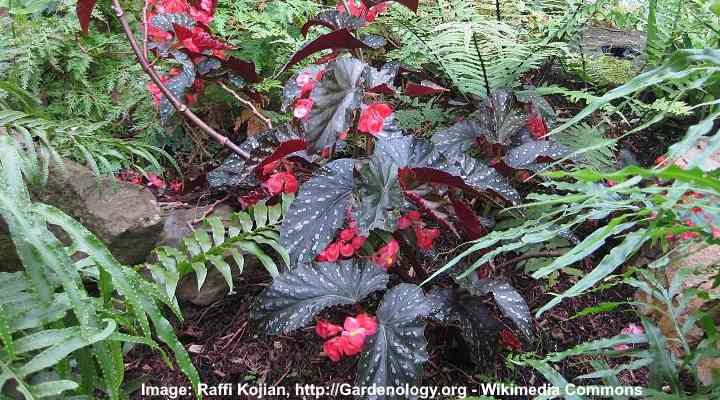
Stem cuttings are the ideal way to propagate angel wing begonias. Next, make sure the cane stems are at least 6 inches (15 centimeters) long before cutting them near a node. Place the roots in a jar of water after removing all the leaves except the top ones and placing them in there.
Plant in a loose, moist potting soil when the roots have grown to about 1″ (2.5 cm). Instead, you can put the cane cuttings directly in potting soil. The begonia cutting is rooted after a few weeks of gently tugging on the begonia stem.
How to Plant Angel Wing Begonia in the Garden
In tropical and subtropical regions, angel wing begonias are lovely leafy flowering plants. As long as the temperature never falls below 55°F (13°C), you can sow the winged begonias outdoors. A helpful guide to growing angel wing begonias outdoors is as follows:
When to plant angel wing begonia: Before planting the begonias in the ground, wait until the threat of frost has passed. Frost will harm the leaves and roots of the plants, which are not resistant to cold.
Where to plant angel wing begonia: Angel wing begonias prefer partial shade or dappled sunlight for the best growth. Depending on the hybrid’s spread, plant begonias between 1 and 3 feet (0.3 and 1 metre) apart. Begonia plants grown outdoors perform best in tropical climates with two hours of morning sunlight every day.
How to plant angel wing begonia: In loamy soil that is well-draining, plant angel wing begonias. When the threat of frost has passed, transfer the rooted begonias to the garden.
Growing Angel Wing Begonias in Containers

Angel wing begonias are simple to maintain in containers, with their broad triangular leaves. Container gardens, patios, and deck areas with glossy green foliage and red, orange, pink, or white flowers are appealing. Angel wing begonias need a loose, well-drained potting mix to thrive in containers outside.
Make sure the pot has drainage slots, then replace the soil with organic matter and perlite for nutrients. Outdoor begonias planted in pots need watering more often than those planted in the ground. Only when the top soil layer is dry should you water the plants.
Angel Wing Begonia in Hanging Basket
Because of its drooping flower clusters and long, arching stems, the angel wing begonia is also known as the hanging begonia. When the hanging plant is in bloom, masses of pink or red flower clusters cover the plant, creating a stunning display of cascading hues. Begonia blossoms prefer dappled light or partial shade, and they thrive best in these conditions.
How to Overwinter Angel Wing Begonias
It’s critical to overwinter begonias indoors throughout the winter if you reside in USDA zones 9 and lower. Bring the potted begonias inside at night and then out again during the day to acclimate them. The angel wing begonia may be kept in a bright location in your home for a week after it has been out of direct light.
Growing Angel Wing Begonia Indoors
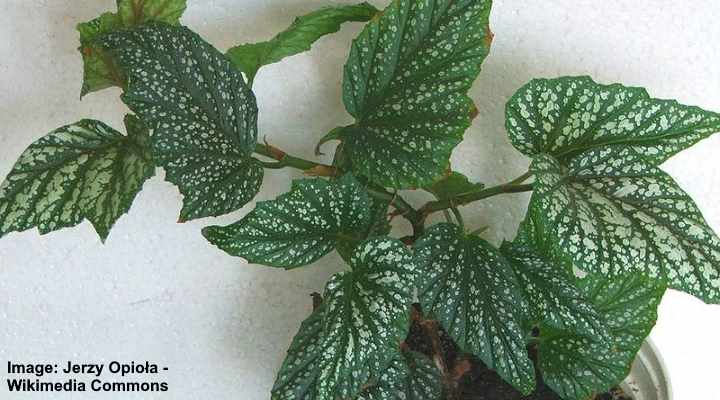
Angel wing begonias are low-maintenance, easy-care houseplants that flourish in indirect light when cultivated indoors. The potted begonia is usually kept in bright indirect light, watered when the soil is mostly dry, and fertilized with a balanced fertilizer to ensure lush foliage and abundant flowers. Now, let’s learn how to grow angel wing houseplants in more depth.
Light Requirements for Angel Wing Begonia Houseplants
Bright, indirect light is ideal for angel wing begonias, which are shielded from harsh direct sun. The best way to ensure the begonia blooms indoors is by getting enough sunlight and fertilizer. Begonia coccinea and Begonia aconitifolia grow in dappled light and produce evergreen foliage year-round in their native habitat.
Angel wing begonia hybrids aren’t as hardy as wax begonias when it comes to sunlight. Nonetheless, they aren’t as delicate to light as rex begonias.
Angel wing begonias thrive in the best light indoors, so it’s a good idea to keep that in mind when planning your summer bloom. The stunning glossy leaves and bushy foliage of this plant, in addition to the fact that you don’t get begonia flowers, make it a lovely houseplant.
The Best Potting Mix for Angel Wing Begonia Houseplants

Angel wing begonia thrives in a moist, yet not soggy, potting soil. Two parts peat moss, one part compost, one part perlite, and a tablespoon of limestone are used to make the ideal houseplant soil for begonias. In an African violet commercial mix, you can also grow begonia houseplants.
Moisture should be retained in the perfect begonia soil without becoming soggy or waterlogged. Houseplant soil moisture retention is best achieved with peat moss or coco coir. Composition provides nutrients to support prolific greenery and blooms, while perlite helps to enhance drainage.
How to Water Angel Wing Begonia Indoor Plants
Keep the soil moist but not soggy by watering an angel wing begonia every day. Wait until the top 1” to 2″ (2.5 to 5 cm) of soil is dry before watering the begonia. After that, thoroughly soak the soil until the pot’s drainage holes are overflowing with water.
When the leaf edges of an angel wing begonia turn brown, it’s a sign that you should water it. Roots rot and the brilliant leafy leaves wilt if there is too much water in the soil. Remember that a potted begonia plant requires less watering throughout the winter.
Temperature Requirement for Indoor Angel Wing Begonia
An angel wing begonia should be kept between 65°F and 75°F (18°C and 24°C) at all times. The leaves of this plant would be damaged if it fell below 55°F (12°C), even at a minimum temperature of 50°F (10°C). As a result, growing an angel wing houseplant is best at room temperatures of about 70 degrees Fahrenheit.
It’s critical to keep the growing angel wing begonias away from chilly breezes when they’re grown indoors. Air conditioning in the summer or an open window in the winter, for example, may stress the plant and cause wing leaves to wilt and die.
Angel Wing Begonia Humidity Needs

Angel wing begonia prefers warm temperatures and requires a lot of humidity. Sits the leafy houseplant on a pebble tray half-filled with water to create ideal growing conditions. You could also grow your tropical plants together in a group. Alternatively, a relative humidity of over 50% may be maintained by using a humidifier in the room.
Is it safe to touch angel plant begonia leaves? Daily misting of the triangular begonia leaves is said to help increase humidity. If room air moisture levels are insufficient and the leaves acquire brown tips, this is merely a short-term solution. Additionally, fungal infections and powdery mildew may be caused by excessive moisture on the leaves.
How to Fertilize Angel Wing Begonia in Pots
Since it is a heavy bloomer, angel wing begonia benefits from frequent fertilization. Every week, apply a one-quarter strength houseplant fertilizer. You may reduce the fertilizer concentration to half-strength if you want to encourage rich flower and foliage colors. The NPK rating of 5-10-5 on a high-phosphorus fertilizer encourages blooming.
Repotting Angel Wing Begonia
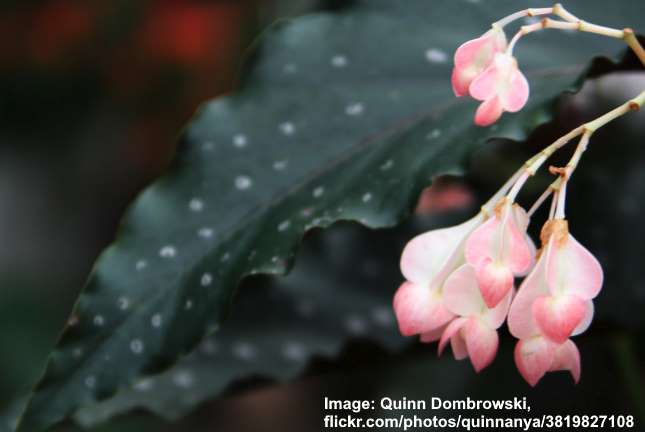
When somewhat root-bound, angel wing begonia plants perform better. To provide the roots room to develop, refresh the potting soil, and check for signs of root damage, you can repot the begonia plant every two years. Early spring is the best season to repot a plant that is thriving.
Choose a pot that is one size larger than the current one when repotting a begonia. In addition, because it offers the greatest houseplant stability, a terracotta pot is the finest option. It also helps to speed up the drying of excess moisture from the soil.
Pests and Diseases Affecting Angel Wing Begonia Growth
Aphids and spider mites can attack Angel wing begonia houseplants. Little flies crawling under the leaves or flying around your plants are signs of an aphid infestation. By inspecting web-like thread stretched from stems and leaves, you may notice spider mites. Little red or black mites with spider-like features can be found.
Houseplant pests can be controlled with a neem oil spray. Mix in a tsp. of salt and 1 cup of sugar. 1 tsp. of neem oil Fill a spray bottle with 1 quart (1 liter) of water and liquid Castile soap. To mix the ingredients, simply shake them. To get rid of plant bugs and mites, thoroughly drench the leaves once a week. Keep applying neem oil until no traces of pests remain.
If you water cane begonias frequently or the soil has poor drainage, root rot may be an issue. It’s critical to repot your plant in fresh potting soil, eliminate dead roots, and water it properly in the future if you discover that the canes are mushy.
Is Angel Wing Cane Begonia Toxic?

Plants in the Begoniaceae family, such as Angel wing begonia, are poisonous to cats and dogs. Dogs and cats may vomit and drool excessively if they consume pieces of begonia stems, leaves, or roots, according to the ASPCA.
How to Get Angel Wing Begonia to Bloom Indoors
In the perfect environment, Angel wing begonias blossom indoors. Angel wing begonia should be grown in bright, indirect light and warm temperatures with enough humidity to ensure that it blooms. When the soil is mostly dry, water the angel wing begonia plant. To promote the begonia houseplant to bloom, you can also apply a diluted high-phosphorus fertilizer.
